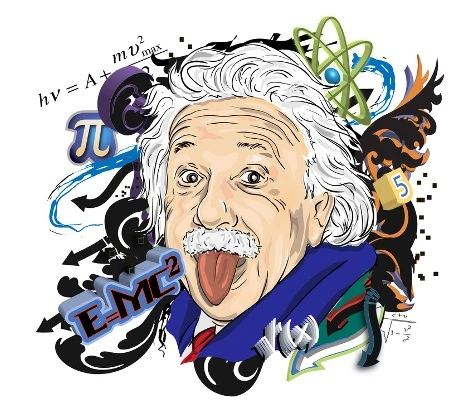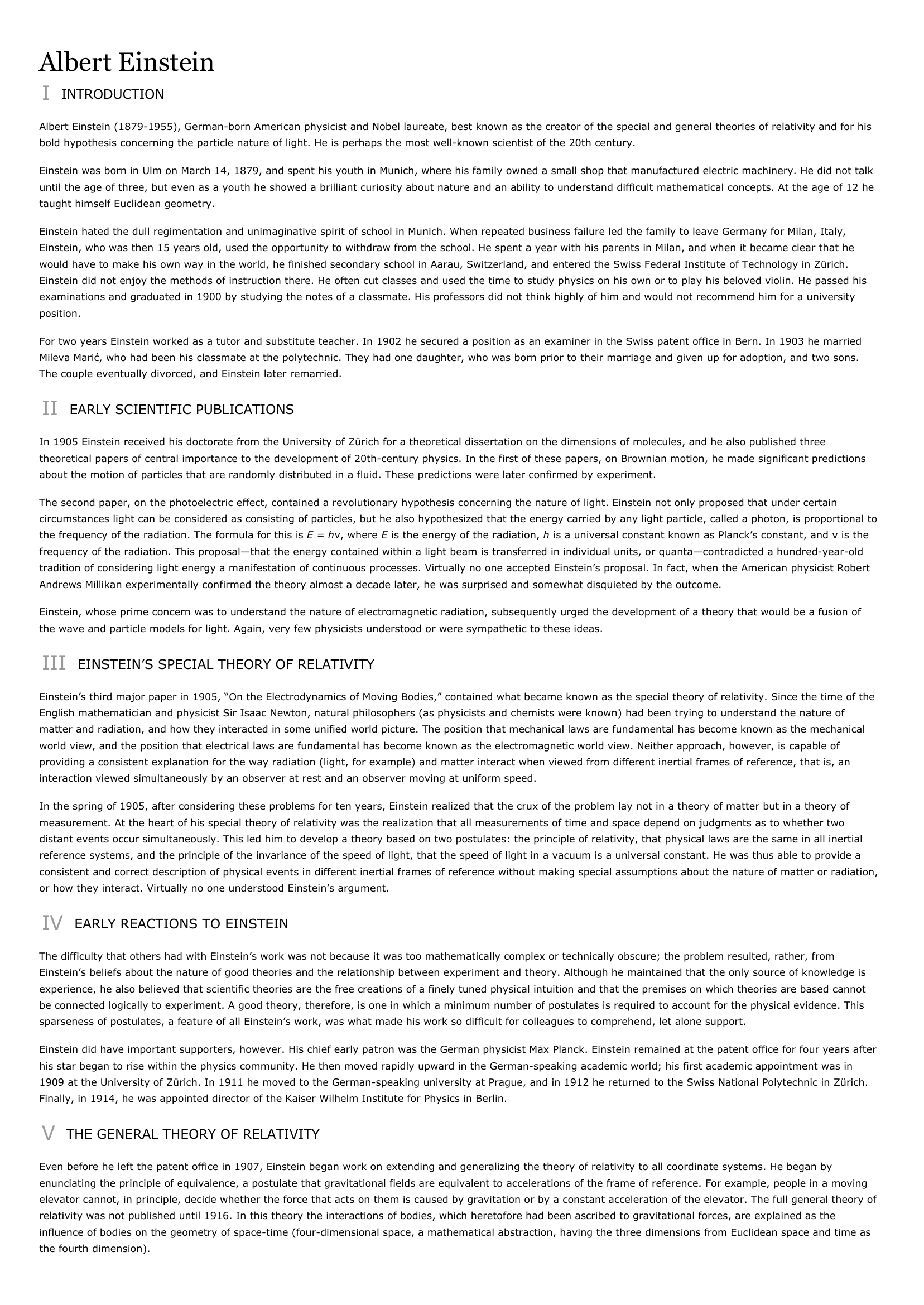Einstein Albert
Publié le 01/04/2019

Extrait du document

Einstein Albert Physicien physicien d'origine allemande, de nationalité suisse, puis américaine après 1940
* 14.3.1879, Ulm
+ 18.4.1955, Princeton, New Jersey
En imaginant la théorie de la relativité restreinte (1905) puis générale (1914-16), Einstein pose les bases d'une nouvelle conception physique du monde et renverse les deux piliers de la physique décrite par Isaac Newton (1643-1727) qui s'appuie sur les concepts d'espace et de temps absolus. Sa théorie de la relativité met l'espace et le temps en relation avec la gravitation (attraction des masses, pesanteur). Elle est contenue dans la célèbre formule mathématique E=mc2 (E = énergie, m = masse, c = vitesse de la lumière). Ces relations théoriques entre masse et énergie sont rapidement confirmées par des expériences pratiques en physique atomique et trouvent leur application la plus spectaculaire dans le développement de la bombe atomique qu'Einstein condamne vivement toute sa vie durant.
Ce n'est cependant pas pour la théorie de la relativité qu'Einstein reçoit le prix Nobel de Physique en 1921, mais pour l'explication de l'effet photoélectrique par les moyens de la théorie quantique avec laquelle il pose les bases d'une théorie quantique du rayonnement.
Citoyen actif, Einstein prend souvent position dans des questions politiques. Persécuté en Allemagne en tant que juif, pacifiste et socialiste, il se voit contraint d'émigrer aux Etats-Unis en 1933, au moment de l'avènement du national-socialisme. En 1939, attirant l'attention du président américain Theodore Roosevelt sur les potentialités des armes atomiques, il donne indirectement la première impulsion au projet atomique américain baptisé \"Manhattan Project\", conduit par Robert Oppenheimer. Après la guerre, figure de proue de la communauté scientifique de son époque, Einstein luttera jusqu'à sa mort contre toute nouvelle utilisation de l'armement atomique.

«
Albert Einstein
I INTRODUCTION
Albert Einstein (1879-1955), German-born American physicist and Nobel laureate, best known as the creator of the special and general theories of relativity and for his bold hypothesis concerning the particle nature of light.
He is perhaps the most well-known scientist of the 20th century.
Einstein was born in Ulm on March 14, 1879, and spent his youth in Munich, where his family owned a small shop that manufactured electric machinery.
He did not talkuntil the age of three, but even as a youth he showed a brilliant curiosity about nature and an ability to understand difficult mathematical concepts.
At the age of 12 hetaught himself Euclidean geometry.
Einstein hated the dull regimentation and unimaginative spirit of school in Munich.
When repeated business failure led the family to leave Germany for Milan, Italy,Einstein, who was then 15 years old, used the opportunity to withdraw from the school.
He spent a year with his parents in Milan, and when it became clear that hewould have to make his own way in the world, he finished secondary school in Aarau, Switzerland, and entered the Swiss Federal Institute of Technology in Zürich.Einstein did not enjoy the methods of instruction there.
He often cut classes and used the time to study physics on his own or to play his beloved violin.
He passed hisexaminations and graduated in 1900 by studying the notes of a classmate.
His professors did not think highly of him and would not recommend him for a universityposition.
For two years Einstein worked as a tutor and substitute teacher.
In 1902 he secured a position as an examiner in the Swiss patent office in Bern.
In 1903 he marriedMileva Marić, who had been his classmate at the polytechnic.
They had one daughter, who was born prior to their marriage and given up for adoption, and two sons.The couple eventually divorced, and Einstein later remarried.
II EARLY SCIENTIFIC PUBLICATIONS
In 1905 Einstein received his doctorate from the University of Zürich for a theoretical dissertation on the dimensions of molecules, and he also published threetheoretical papers of central importance to the development of 20th-century physics.
In the first of these papers, on Brownian motion, he made significant predictionsabout the motion of particles that are randomly distributed in a fluid.
These predictions were later confirmed by experiment.
The second paper, on the photoelectric effect, contained a revolutionary hypothesis concerning the nature of light.
Einstein not only proposed that under certaincircumstances light can be considered as consisting of particles, but he also hypothesized that the energy carried by any light particle, called a photon, is proportional tothe frequency of the radiation.
The formula for this is E = hν , where E is the energy of the radiation, h is a universal constant known as Planck’s constant, and ν is the frequency of the radiation.
This proposal—that the energy contained within a light beam is transferred in individual units, or quanta—contradicted a hundred-year-oldtradition of considering light energy a manifestation of continuous processes.
Virtually no one accepted Einstein’s proposal.
In fact, when the American physicist RobertAndrews Millikan experimentally confirmed the theory almost a decade later, he was surprised and somewhat disquieted by the outcome.
Einstein, whose prime concern was to understand the nature of electromagnetic radiation, subsequently urged the development of a theory that would be a fusion ofthe wave and particle models for light.
Again, very few physicists understood or were sympathetic to these ideas.
III EINSTEIN’S SPECIAL THEORY OF RELATIVITY
Einstein’s third major paper in 1905, “On the Electrodynamics of Moving Bodies,” contained what became known as the special theory of relativity.
Since the time of theEnglish mathematician and physicist Sir Isaac Newton, natural philosophers (as physicists and chemists were known) had been trying to understand the nature ofmatter and radiation, and how they interacted in some unified world picture.
The position that mechanical laws are fundamental has become known as the mechanicalworld view, and the position that electrical laws are fundamental has become known as the electromagnetic world view.
Neither approach, however, is capable ofproviding a consistent explanation for the way radiation (light, for example) and matter interact when viewed from different inertial frames of reference, that is, aninteraction viewed simultaneously by an observer at rest and an observer moving at uniform speed.
In the spring of 1905, after considering these problems for ten years, Einstein realized that the crux of the problem lay not in a theory of matter but in a theory ofmeasurement.
At the heart of his special theory of relativity was the realization that all measurements of time and space depend on judgments as to whether twodistant events occur simultaneously.
This led him to develop a theory based on two postulates: the principle of relativity, that physical laws are the same in all inertialreference systems, and the principle of the invariance of the speed of light, that the speed of light in a vacuum is a universal constant.
He was thus able to provide aconsistent and correct description of physical events in different inertial frames of reference without making special assumptions about the nature of matter or radiation,or how they interact.
Virtually no one understood Einstein’s argument.
IV EARLY REACTIONS TO EINSTEIN
The difficulty that others had with Einstein’s work was not because it was too mathematically complex or technically obscure; the problem resulted, rather, fromEinstein’s beliefs about the nature of good theories and the relationship between experiment and theory.
Although he maintained that the only source of knowledge isexperience, he also believed that scientific theories are the free creations of a finely tuned physical intuition and that the premises on which theories are based cannotbe connected logically to experiment.
A good theory, therefore, is one in which a minimum number of postulates is required to account for the physical evidence.
Thissparseness of postulates, a feature of all Einstein’s work, was what made his work so difficult for colleagues to comprehend, let alone support.
Einstein did have important supporters, however.
His chief early patron was the German physicist Max Planck.
Einstein remained at the patent office for four years afterhis star began to rise within the physics community.
He then moved rapidly upward in the German-speaking academic world; his first academic appointment was in1909 at the University of Zürich.
In 1911 he moved to the German-speaking university at Prague, and in 1912 he returned to the Swiss National Polytechnic in Zürich.Finally, in 1914, he was appointed director of the Kaiser Wilhelm Institute for Physics in Berlin.
V THE GENERAL THEORY OF RELATIVITY
Even before he left the patent office in 1907, Einstein began work on extending and generalizing the theory of relativity to all coordinate systems.
He began byenunciating the principle of equivalence, a postulate that gravitational fields are equivalent to accelerations of the frame of reference.
For example, people in a movingelevator cannot, in principle, decide whether the force that acts on them is caused by gravitation or by a constant acceleration of the elevator.
The full general theory ofrelativity was not published until 1916.
In this theory the interactions of bodies, which heretofore had been ascribed to gravitational forces, are explained as theinfluence of bodies on the geometry of space-time (four-dimensional space, a mathematical abstraction, having the three dimensions from Euclidean space and time asthe fourth dimension)..
»
↓↓↓ APERÇU DU DOCUMENT ↓↓↓
Liens utiles
- COMMENT JE VOIS LE MONDE, Albert Einstein (résumé)
- Le problème du rapport théorie-expérience - Albert Einstein
- Albert Einstein par Louis de Broglie de l'Académie française et de l'Académie des Sciences.
- Allemand d'origine, Albert Einstein changea deux fois de nationalité.
- Albert Einstein - ciencia y tecnologia.









